ARDENNES-ALSACE
 The decision to replace the 94th Infantry division in Brittany was decided not by a Generals Eisenhower, Bradley or Simpson but rather by Adolf Hitler and a lone U-boat Commander. Two separate incidents that decided the fate of the 94th Infantry Division. The 90th Infantry Division was deployed in anticipation of an attack on the "Switch" but when Hitler launched his Ardennes Offensive, the 90th broke off its attack on the “Switch” and was ordered North to help repel the breakthrough. The Division that was chosen to replace the 90th was the 66th Division,
"the Black Panthers", but one of the troop ships the S.S. Leopoldville which was carrying the 262nd and 264th Infantry regiments of the Division was torpedoed by Oblt. Gerhard Meyer in U-486 about six miles from Cherbourg on Christmas Eve. The 66th division lost over 800 men. This action severely shook the fighting ability of the 66th. So it was decided that the 94th would be called up from the Lorient-St. Nazaire Pocket to replace the 90th Infantry division in the ”Siegfried Switch”.
The decision to replace the 94th Infantry division in Brittany was decided not by a Generals Eisenhower, Bradley or Simpson but rather by Adolf Hitler and a lone U-boat Commander. Two separate incidents that decided the fate of the 94th Infantry Division. The 90th Infantry Division was deployed in anticipation of an attack on the "Switch" but when Hitler launched his Ardennes Offensive, the 90th broke off its attack on the “Switch” and was ordered North to help repel the breakthrough. The Division that was chosen to replace the 90th was the 66th Division,
"the Black Panthers", but one of the troop ships the S.S. Leopoldville which was carrying the 262nd and 264th Infantry regiments of the Division was torpedoed by Oblt. Gerhard Meyer in U-486 about six miles from Cherbourg on Christmas Eve. The 66th division lost over 800 men. This action severely shook the fighting ability of the 66th. So it was decided that the 94th would be called up from the Lorient-St. Nazaire Pocket to replace the 90th Infantry division in the ”Siegfried Switch”.
All Points East
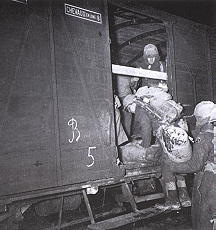 The 66th relieved the 94th on New Years Day 1945. Following their relief the division assembled in Chateaubriant and Plouay. On January 2nd the division boarded trucks and proceeded to Rennes. On January 5th, after a three day encampment the men shuffled into boxcars. “40’s and 8’s” as it was marked on them. The trains were designed to carry 40 men or 8 horses. However, each cramped boxcar only held 27 men with packs and weapons. For three freezing days the train alternately sped then crawled toward its final destination Reims, France near the Luxembourg and German Border. The division was allowed three days to travel by motor to Reims. As the 94th moved east the names on the signposts became too familiar: The Marne, Chateau-Thierry,
Meaux, Dormans, Epernay, and Soissons, cities and towns famous from the First World War. Once at
Reims the divisions continued its journey past Verdun until it reached the final destination of Sierck on the French border. After relieving the troopers of the 3rd Calvary the 94th settled in to their defensive position south of the "Siegfried Switch".
The 66th relieved the 94th on New Years Day 1945. Following their relief the division assembled in Chateaubriant and Plouay. On January 2nd the division boarded trucks and proceeded to Rennes. On January 5th, after a three day encampment the men shuffled into boxcars. “40’s and 8’s” as it was marked on them. The trains were designed to carry 40 men or 8 horses. However, each cramped boxcar only held 27 men with packs and weapons. For three freezing days the train alternately sped then crawled toward its final destination Reims, France near the Luxembourg and German Border. The division was allowed three days to travel by motor to Reims. As the 94th moved east the names on the signposts became too familiar: The Marne, Chateau-Thierry,
Meaux, Dormans, Epernay, and Soissons, cities and towns famous from the First World War. Once at
Reims the divisions continued its journey past Verdun until it reached the final destination of Sierck on the French border. After relieving the troopers of the 3rd Calvary the 94th settled in to their defensive position south of the "Siegfried Switch".
"SIEGFRIED SWITCH"

 On January 10, 1945 the 94th Division officially became part of the XX corps of the U.S. Third Army under General George S Patton, Jr. XX Corps was under the command of General Walton H. Walker a classmate of General Maloney. The Saar region was always considered by the Germans as a key area in the defense of the German Reich. The Saar-Moselle triangle began at the meeting point of the Saar and Moselle rivers. It extended along a line running east to west along the Luxembourg border. The base of the triangle was 13 miles long and ran from Nennig in the west to Orscholz in the east. The Germans called this line of defense the Orscholz Oblique Switch. The Americans dubbed it the “Siegfried Switch” in the fall of 1944. The Switch consisted of defensive positions up to two miles in depth. Protected by dragon’s teeth and anti-tank ditches. In addition to the Siegfried defenses there were pillboxes and concrete bunkers, and the entire area was located on high ground. Although the division was in a defensive position it was well understood that this was a temporary arrangement.
On January 10, 1945 the 94th Division officially became part of the XX corps of the U.S. Third Army under General George S Patton, Jr. XX Corps was under the command of General Walton H. Walker a classmate of General Maloney. The Saar region was always considered by the Germans as a key area in the defense of the German Reich. The Saar-Moselle triangle began at the meeting point of the Saar and Moselle rivers. It extended along a line running east to west along the Luxembourg border. The base of the triangle was 13 miles long and ran from Nennig in the west to Orscholz in the east. The Germans called this line of defense the Orscholz Oblique Switch. The Americans dubbed it the “Siegfried Switch” in the fall of 1944. The Switch consisted of defensive positions up to two miles in depth. Protected by dragon’s teeth and anti-tank ditches. In addition to the Siegfried defenses there were pillboxes and concrete bunkers, and the entire area was located on high ground. Although the division was in a defensive position it was well understood that this was a temporary arrangement.
Piercing the Switch: TETTINGEN-BUTZDORF
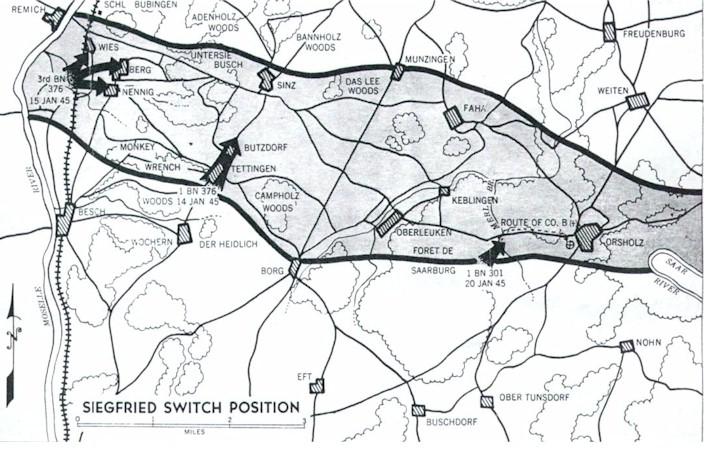 On January 12th the 376th the 1st battalion was given the order to attack and take the city of Tettingen. The plan was to attack key positions within the Triangle in order to wear down the enemy thus forcing him to move his reserves from the Ardennes sector and relieve pressure from the Bulge. Facing the Americans were the troops of the 713th Regiment of the 416th Infanterie Divisionen. The 713th was a veteran regiment that fought in Russia. The unit was low on food and morale but well rested. The commanding officer of the 1st battalion of the 713th Regiment was a Major Becker. His entire strength was approximately 500 men between Tettingen and Nennig. For artillery he had a wide variety of mortars and 88mm guns scattered throughout the hills and wooded areas, ammunition was low, but they were available for fire support upon request.
On January 12th the 376th the 1st battalion was given the order to attack and take the city of Tettingen. The plan was to attack key positions within the Triangle in order to wear down the enemy thus forcing him to move his reserves from the Ardennes sector and relieve pressure from the Bulge. Facing the Americans were the troops of the 713th Regiment of the 416th Infanterie Divisionen. The 713th was a veteran regiment that fought in Russia. The unit was low on food and morale but well rested. The commanding officer of the 1st battalion of the 713th Regiment was a Major Becker. His entire strength was approximately 500 men between Tettingen and Nennig. For artillery he had a wide variety of mortars and 88mm guns scattered throughout the hills and wooded areas, ammunition was low, but they were available for fire support upon request.
At 0500 on January 14th the 1st battalion of the 376th Infantry moved up past the town of Wochern to get in position. At 0710 the attack commenced with an opening round of artillery fire from the 919th Field artillery battalion. After twenty minutes of fire the GI’s from A and C Companies advanced in a Pincer movement on the town. The Germans were taken completely by surprise. The Americans quickly routed through the houses in town and captured 23 prisoners. The entire battle was over in an hour. Quickly the men of the 376th set up defensive positions in town an awaited a counterattack. The success of Tettingen was so complete that the decision was made to exploit it. After a quick preparation the men continued their attack towards Butsdorf. They seized it after another short intense battle. Now the Americans had taken two towns and penetrated about two miles into the Siegfried line. The Americans dug in for the night and waited. The Germans were not about to sit still and let the Americans have their victories. Immediately artillery fire began to fall on the two towns throughout the day and into the evening. The GI’s scrambling for cover wherever they could find it, several men were wounded from the shelling. Next came the expected counterattack. A battalion from the 714th Grenadier regiment of the 416th Division attacked the town in the darkness of early morning. Hundreds of Germans streamed down the hill and surrounded Butsdorf and advanced to the buildings in Tettingen. For three hours the fighting ensued with many casualties on both sides. The German attack was repulsed, Tettingen and Butsdorf remained in the 94th ‘s hands, over sixty prisoners were taken, with many enemy casualties of dead and wounded scattered throughout the two towns. The successful defense of Tettingen and Butsdorf was a tribute to the training and discipline of the 94th. The men would be tested again as the Germans were not about to give up so easily.
Counterattack on TETTINGEN
 The 11th Panzer division was enroute to Trier when it received the order to divert towards the penetration in the Siegfried line on January 15th . After arriving on the 17th the 11th Panzer Division nicknamed the “Ghost” Division went immediately into action against the towns of Butsdorf and Tettingen. The 11th panzer committed its tanks and assault guns into the battle along with an entire battalion of Panzer Grenadiers. They attacked the right flank in between the two towns. After intense artillery barrage and tank shell fire the towns literally disintegrated. The GI’s were receiving a pasting; the panzers rolled right into the town and were firing point blank into the houses. The Germans advanced into the center of Butsdorf and retook several houses in north Tettingen. The GI’s countered the onslaught with mortar, artillery, bazooka and concentrated machine gun fire. But the men of 1st battalion held on and the Germans were unable to capitalize on their gains. At 0900 the Germans withdrew from the towns. Two hours later a second assault came from the north of Butsdorf about ten Mark V “Panther” tanks moved in against the towns. The panzers along with 3 battalions of infantry managed to penetrate the defenses. The panthers roamed the town at will firing point blank into the houses with armor piercing and high explosive rounds. The men from A company were the only defenders left in Butsdorf and they were hanging on by their fingernails. The Germans managed to capture most of the houses in Butsdorf and the decision was made to abandon the town. Later that night under a cover of darkness the men withdrew to Tettingen. The attack of Tettingen was over, but the Americans could claim success. They managed to destroy many of the panzers deployed against them with bazooka fire and satchel charges. In addition they seriously depleted the Germans ranks of men. Even though the GI's had to retreat form the gains made the previous day they still had Tettingen and had pierced the impenetrable Siegfried Line.
The 11th Panzer division was enroute to Trier when it received the order to divert towards the penetration in the Siegfried line on January 15th . After arriving on the 17th the 11th Panzer Division nicknamed the “Ghost” Division went immediately into action against the towns of Butsdorf and Tettingen. The 11th panzer committed its tanks and assault guns into the battle along with an entire battalion of Panzer Grenadiers. They attacked the right flank in between the two towns. After intense artillery barrage and tank shell fire the towns literally disintegrated. The GI’s were receiving a pasting; the panzers rolled right into the town and were firing point blank into the houses. The Germans advanced into the center of Butsdorf and retook several houses in north Tettingen. The GI’s countered the onslaught with mortar, artillery, bazooka and concentrated machine gun fire. But the men of 1st battalion held on and the Germans were unable to capitalize on their gains. At 0900 the Germans withdrew from the towns. Two hours later a second assault came from the north of Butsdorf about ten Mark V “Panther” tanks moved in against the towns. The panzers along with 3 battalions of infantry managed to penetrate the defenses. The panthers roamed the town at will firing point blank into the houses with armor piercing and high explosive rounds. The men from A company were the only defenders left in Butsdorf and they were hanging on by their fingernails. The Germans managed to capture most of the houses in Butsdorf and the decision was made to abandon the town. Later that night under a cover of darkness the men withdrew to Tettingen. The attack of Tettingen was over, but the Americans could claim success. They managed to destroy many of the panzers deployed against them with bazooka fire and satchel charges. In addition they seriously depleted the Germans ranks of men. Even though the GI's had to retreat form the gains made the previous day they still had Tettingen and had pierced the impenetrable Siegfried Line.
Capture of Nennig, Berg, And Wies
 The rest of the 376th was not idle as the 3rd battalion was ordered to capture three small towns situated on the mud flats of the Moselle River. Nennig, Berg and Wies. Nennig was a town comprised of fifty stone buildings. Wies was a smaller village with about thirty buildings and Berg was the smallest town with but twenty buildings and a castle. At 3:00 A.M., on the morning of January 15th the 319th engineers began sweeping a path through the minefields. At 0715 the 3rd battalion launched its attack. However due to some faulty navigating the attacking company had come out of the woods too far to the North. Adapting to the situation, K Company improvised and attacked from the North rather than from the west as planned. The attack on Nennig was a complete success as the Germans were expecting an attack from the south. The GI’s came at them from behind and quickly overran the town. They captured 23 prisoners and inflicted 95 casualties on the enemy. The remaining
Germans fled north towards Sinz. Once Nennig was secured the next objective was Wies 2nd platoon from k Company ran into about fifty
Germans there and bloody house-to-house fighting erupted. During a lull in the fighting town a small detachment from 2nd platoon came under intense fire, and was soon pinned down by enemy machine gun, as they attempted to cross an open field just north of the town. The men hopelessly trapped, accepted a German surrender proposal in order to save the lives of their wounded comrades. The men from L Company took over the assault on Wies. Enemy machine guns located in the northern section of the town would continue to harass the men as they attempted to take the town again. Only after concentrated artillery fire on the positions were the men from L Company able to clear the town. After Wies was finally secured the attacked moved
The rest of the 376th was not idle as the 3rd battalion was ordered to capture three small towns situated on the mud flats of the Moselle River. Nennig, Berg and Wies. Nennig was a town comprised of fifty stone buildings. Wies was a smaller village with about thirty buildings and Berg was the smallest town with but twenty buildings and a castle. At 3:00 A.M., on the morning of January 15th the 319th engineers began sweeping a path through the minefields. At 0715 the 3rd battalion launched its attack. However due to some faulty navigating the attacking company had come out of the woods too far to the North. Adapting to the situation, K Company improvised and attacked from the North rather than from the west as planned. The attack on Nennig was a complete success as the Germans were expecting an attack from the south. The GI’s came at them from behind and quickly overran the town. They captured 23 prisoners and inflicted 95 casualties on the enemy. The remaining
Germans fled north towards Sinz. Once Nennig was secured the next objective was Wies 2nd platoon from k Company ran into about fifty
Germans there and bloody house-to-house fighting erupted. During a lull in the fighting town a small detachment from 2nd platoon came under intense fire, and was soon pinned down by enemy machine gun, as they attempted to cross an open field just north of the town. The men hopelessly trapped, accepted a German surrender proposal in order to save the lives of their wounded comrades. The men from L Company took over the assault on Wies. Enemy machine guns located in the northern section of the town would continue to harass the men as they attempted to take the town again. Only after concentrated artillery fire on the positions were the men from L Company able to clear the town. After Wies was finally secured the attacked moved
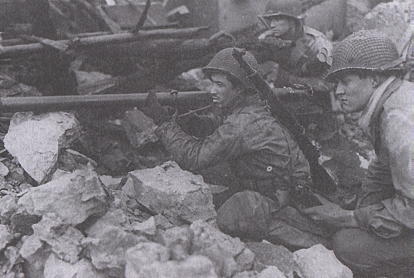 on toward Berg and that small town was cleared by 1730, which completed the battalions mission. Two days later the enemy mounted a counterattack. About 100 men stormed into Berg and for over two hours fought hand to hand with the GI’s after a bloody battle the men from 2nd battalion repulsed the assault. The Germans lost sixty dead and scores wounded.
After they secured the area and mopped up all remaining resistance the men of the 376th were relieved by 2nd battalion of the 302nd Infantry regiment. The 11th panzer division launched several counterattacks on Nennig on January 21st and 22nd but the resilient GI’s held their ground.
on toward Berg and that small town was cleared by 1730, which completed the battalions mission. Two days later the enemy mounted a counterattack. About 100 men stormed into Berg and for over two hours fought hand to hand with the GI’s after a bloody battle the men from 2nd battalion repulsed the assault. The Germans lost sixty dead and scores wounded.
After they secured the area and mopped up all remaining resistance the men of the 376th were relieved by 2nd battalion of the 302nd Infantry regiment. The 11th panzer division launched several counterattacks on Nennig on January 21st and 22nd but the resilient GI’s held their ground.
Counterattack on Nennig
The next day the Germans started to push the Americans out of the southern half of Nennig and things looked pretty bleak for the GI’s. It was at this time that General Maloney decided to commit his armor.
Combat Command A, of the 8th Armored Division was on loan to the 94th for two days, and General Maloney immmediately sent them in to assist the battered 302nd. Once the 8th Armored was committed, a knock down drag-out fight ensued through most of the
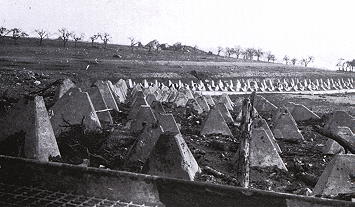 The 11th panzer division under the Command of General Weitersheim had simple orders: push the Americans out of their gains in the Siegfried Switch and restore the German lines back to their original positions. After the 376th gained a foothold in the Nennig area, the Germans were determined to push them back. The first attack came in the morning of January 20th, five Pzkw Mark IV’s loaded with Infantry on them, stormed into Nennig from the North. The Americans responded with artillery fire and broke up the assault. Another assault was launched later that evening, but it too was repulsed. The next day was quiet until about 2100 when an intense artillery barrage rocked Nennig. German infantry and tanks rolled down the hill to the east of Nennig and made another attempt to take the town. This time the Germans managed to get into the town, and the Panzers were firing point blank into the houses. By the next morning the Germans had pushed the Americans back into the southern half of the town. Meanwhile, at Berg, the Americans were pushed back into the castle known as Schloss-Berg. The Panzers blasted holes in the castle walls at the range of only a few meters. The intended idea was to knock out the Americans resistance. The attacks were so severe that the Americans were barely able to hang on. Only artillery called in from the besieged men and bazooka fire kept the Germans at bay. But the Panzers and Panzergrenadiers were
The 11th panzer division under the Command of General Weitersheim had simple orders: push the Americans out of their gains in the Siegfried Switch and restore the German lines back to their original positions. After the 376th gained a foothold in the Nennig area, the Germans were determined to push them back. The first attack came in the morning of January 20th, five Pzkw Mark IV’s loaded with Infantry on them, stormed into Nennig from the North. The Americans responded with artillery fire and broke up the assault. Another assault was launched later that evening, but it too was repulsed. The next day was quiet until about 2100 when an intense artillery barrage rocked Nennig. German infantry and tanks rolled down the hill to the east of Nennig and made another attempt to take the town. This time the Germans managed to get into the town, and the Panzers were firing point blank into the houses. By the next morning the Germans had pushed the Americans back into the southern half of the town. Meanwhile, at Berg, the Americans were pushed back into the castle known as Schloss-Berg. The Panzers blasted holes in the castle walls at the range of only a few meters. The intended idea was to knock out the Americans resistance. The attacks were so severe that the Americans were barely able to hang on. Only artillery called in from the besieged men and bazooka fire kept the Germans at bay. But the Panzers and Panzergrenadiers were
 persistent and the Americans were almost out of ammunition. The remaining men withdrew from the castle and retreated back to Wies.
persistent and the Americans were almost out of ammunition. The remaining men withdrew from the castle and retreated back to Wies. 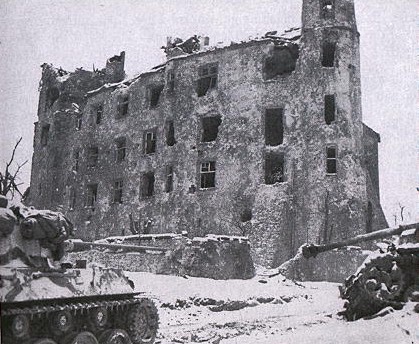 night. The Germans still managed to push the GI’s back, they captured a few more houses and the town’s church. Concerned that he might lose his foothold in the Switch General Maloney committed his reserves. On the Morning of the 23rd, the 2nd battalion of the 376th which was in reserve was committed. For the next two days after concentrated artillery, bazooka, machine gun fire and infantry assaults the 94th and CCA of the 8th Armored pushed the Germans out of Nennig, Wies and Berg. On the 24th they recaptured the Schloss Berg. They kept pushing and drove the Germans out of the town proper, they retreated back towards Sinz leaving their dead and wounded to the Americans.
night. The Germans still managed to push the GI’s back, they captured a few more houses and the town’s church. Concerned that he might lose his foothold in the Switch General Maloney committed his reserves. On the Morning of the 23rd, the 2nd battalion of the 376th which was in reserve was committed. For the next two days after concentrated artillery, bazooka, machine gun fire and infantry assaults the 94th and CCA of the 8th Armored pushed the Germans out of Nennig, Wies and Berg. On the 24th they recaptured the Schloss Berg. They kept pushing and drove the Germans out of the town proper, they retreated back towards Sinz leaving their dead and wounded to the Americans.
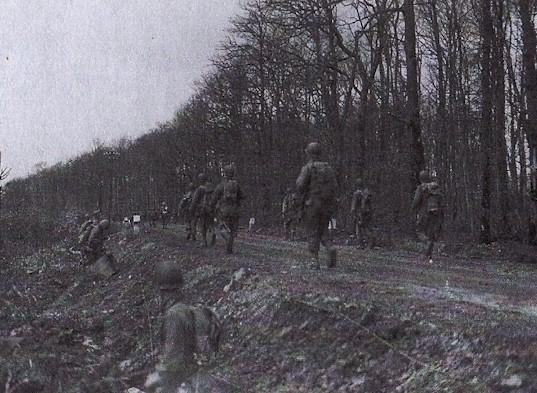 Uncle Freddie's
1st Battalion, 301st Infantry would be involved in this intense battle and the battalion would suffer enormous
casualties. "B" Company would be completely decimated and "C" company along with Uncle Freddie would fight hard and lose many men during this battle in the freezing
weather. Click here to find out the entire story on the battle of Orscholz
Uncle Freddie's
1st Battalion, 301st Infantry would be involved in this intense battle and the battalion would suffer enormous
casualties. "B" Company would be completely decimated and "C" company along with Uncle Freddie would fight hard and lose many men during this battle in the freezing
weather. Click here to find out the entire story on the battle of Orscholz
SINZ: The Lynchpin
On the morning of January 26th the attack for Sinz, Germany commenced. The 302nd holding on to its gains in Nennig needed to be relieved of some of the pressure the Germans were inflicting on them. Taking Sinz about one mile north of Butzdorf, would do the job. The 376th was chosen to make the main effort with the 302nd attacking the left flank and the 301st was chosen to clear Munzingen ridge afterwards. The attacked commenced during a blizzard with a smoke barrage laid on the approaches to Sinz from a platoon from the 81st Chemical Mortar Battalion. Men from the 3rd battalion of the 376th ran into trouble immediately. I Company walked right into a minefield, and many of the men were seriously wounded. The Germans had placed wooden and plastic Schu mines in the path of the GI’s. Due to their construction the mine detectors had been unable to pick them up. AS soon as the first mines went off the enemy was alerted to the attack. The Germans started lobbing mortar rounds on the Battalion, the 376th ‘s attack was stalled. The 2nd battalion of the 302nd managed to advance up to the woods before they too ran into mines. The engineers of the 319th came to the rescue and with primacord blew a path through the minefields so the attack could recommence.
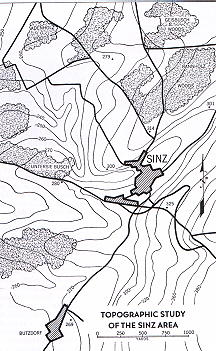 The GIs of the 2nd battalion 302nd fanned out through the woods and waited. 1st battalion of the 302nd meanwhile attacked towards Butsdorf to reclaim that town. Company A supported by Tank destroyers advanced into the town at a high cost. The Germans had reoccupied the pillboxes and made the GI’s pay for every yard of ground. 3rd battalion 376th was withdrawn from the minefield and sent into the Monkey Wrench woods for the night. Then the CCA of the 8th Armored joined in the attack. 1st battalion, 376th and 2nd battalion, 302nd followed the tankers as they pushed towards Untersie Busch and Sinz. The Shermans engaged three Pzkw Mk IV’s and knocked them out. The enemy was cleared up to the edge of the woods, at a cost of seven tanks. After the armor was eliminated, 1st battalion advanced through the woods. The Gi’s came under intense machine gun and tank shell fire and were halted. Meanwhile, 2nd battalion, 302nd continued the attack and advanced two companies into Sinz by nightfall. But the combined strength of these two companies equaled less than a full company. But the two days that General Maloney was allowed to use CCA of the 8th Armored Division had expired, and they were ordered to leave. With their armor support gone, this left the men of the 94th dangerously weakened and vulnerable to armored attack from the 11th panzer. General Maloney decided under the circumstances that without armor support he had to withdraw from Sinz. The Sinz attack was costly in men and material and the 94th had to regroup and re-supply in order to proceed. It would be another week before the Americans would try to take Sinz again. From February 1-2 the division made a limited objective attack and cleared the Campholz Woods southeast of Tettingen. Once the woods were clear the 94th set it’s sights on Sinz again. This time Uncle Freddie’s 301st Infantry would be involved. fought a house-to-house battle and captured Sinz, Germany on February 8th.
The GIs of the 2nd battalion 302nd fanned out through the woods and waited. 1st battalion of the 302nd meanwhile attacked towards Butsdorf to reclaim that town. Company A supported by Tank destroyers advanced into the town at a high cost. The Germans had reoccupied the pillboxes and made the GI’s pay for every yard of ground. 3rd battalion 376th was withdrawn from the minefield and sent into the Monkey Wrench woods for the night. Then the CCA of the 8th Armored joined in the attack. 1st battalion, 376th and 2nd battalion, 302nd followed the tankers as they pushed towards Untersie Busch and Sinz. The Shermans engaged three Pzkw Mk IV’s and knocked them out. The enemy was cleared up to the edge of the woods, at a cost of seven tanks. After the armor was eliminated, 1st battalion advanced through the woods. The Gi’s came under intense machine gun and tank shell fire and were halted. Meanwhile, 2nd battalion, 302nd continued the attack and advanced two companies into Sinz by nightfall. But the combined strength of these two companies equaled less than a full company. But the two days that General Maloney was allowed to use CCA of the 8th Armored Division had expired, and they were ordered to leave. With their armor support gone, this left the men of the 94th dangerously weakened and vulnerable to armored attack from the 11th panzer. General Maloney decided under the circumstances that without armor support he had to withdraw from Sinz. The Sinz attack was costly in men and material and the 94th had to regroup and re-supply in order to proceed. It would be another week before the Americans would try to take Sinz again. From February 1-2 the division made a limited objective attack and cleared the Campholz Woods southeast of Tettingen. Once the woods were clear the 94th set it’s sights on Sinz again. This time Uncle Freddie’s 301st Infantry would be involved. fought a house-to-house battle and captured Sinz, Germany on February 8th.
Seizing Sinz and the Bannholz Woods
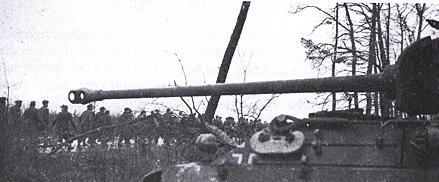 After the failed attempt to take Sinz on January 27, left the 94th's top commander stinging. General Maloney held a meeting with his staff and the regimental commanders on February 3rd to discuss how to best implement the XX Corps order to engage the enemy with a force no larger than a regiment. It was decided at the meeting that the best way to implement this policy would be a regimental assault on the town of Sinz. Two days later general walker came to the division to review the plan. Known as Field order number 10 the 301st Infantry was assigned to attack the Sinz-Bannholz the 376th would later attack Munzingen Ridge and the 302nd a would take Oberleuken. General Walker approved the plan, with a kick off date of February 7th. The attack went off as scheduled 2nd battalion, 301st was the first to reach the town. Company E began securing the houses as the enemy dropped mortar, tank and artillery shells on them. Aided by their own artillery support. The men from Company E continued clearing the town of the Germans taking many prisoners. Storming house to house the men from Company E cleared all the houses on their sector. Meanwhile Company G advanced towards their objective and started clearing the northern half of Sinz. After another house-to-house battle the two companies managed to capture the town and bag 208 prisoners. At the same time Company F moved past Sinz and entered the Bannholz woods. As the company moved through the woods they stumbled into two German Panzers. The company’s bazooka team went quickly to work and attacked the Panzers. After an exchange of fire one of the Panzers knocked out the Company’s bazooka team with a tree burst. Without the bazooka team the company retreated from the forest. Panzergrenadiers from the 4th panzer company assisted the Panzers in driving the GIs from the forest area. The Americans retaliated later that day with Artillery fire and managed to clear the forest of the Germans. The following morning Company L cleared the remaining pillboxes immediately around the area of Sinz. Tank destroyers from the 704th TD battalion moved forward from Sinz came under intense tank fire from the superior guns of the Panzers. Four groups of 25 men each from
After the failed attempt to take Sinz on January 27, left the 94th's top commander stinging. General Maloney held a meeting with his staff and the regimental commanders on February 3rd to discuss how to best implement the XX Corps order to engage the enemy with a force no larger than a regiment. It was decided at the meeting that the best way to implement this policy would be a regimental assault on the town of Sinz. Two days later general walker came to the division to review the plan. Known as Field order number 10 the 301st Infantry was assigned to attack the Sinz-Bannholz the 376th would later attack Munzingen Ridge and the 302nd a would take Oberleuken. General Walker approved the plan, with a kick off date of February 7th. The attack went off as scheduled 2nd battalion, 301st was the first to reach the town. Company E began securing the houses as the enemy dropped mortar, tank and artillery shells on them. Aided by their own artillery support. The men from Company E continued clearing the town of the Germans taking many prisoners. Storming house to house the men from Company E cleared all the houses on their sector. Meanwhile Company G advanced towards their objective and started clearing the northern half of Sinz. After another house-to-house battle the two companies managed to capture the town and bag 208 prisoners. At the same time Company F moved past Sinz and entered the Bannholz woods. As the company moved through the woods they stumbled into two German Panzers. The company’s bazooka team went quickly to work and attacked the Panzers. After an exchange of fire one of the Panzers knocked out the Company’s bazooka team with a tree burst. Without the bazooka team the company retreated from the forest. Panzergrenadiers from the 4th panzer company assisted the Panzers in driving the GIs from the forest area. The Americans retaliated later that day with Artillery fire and managed to clear the forest of the Germans. The following morning Company L cleared the remaining pillboxes immediately around the area of Sinz. Tank destroyers from the 704th TD battalion moved forward from Sinz came under intense tank fire from the superior guns of the Panzers. Four groups of 25 men each from second battalion were sent back into the Bannholz woods to attempt to take and hold it. The men became lost as they moved through the forest and soon only one group of about ten men remained. This group located several enemy tanks. They dug in and waited for the TD’s to move up. Six M-18“Hellcats” came up and proceeded into the woods. After a mixed battle with the Panzers from 11th Panzer five of the TD’s were destroyed and over 20 prisoners taken by the Germans. The one remaining TD left the forest with some wounded men to bring back to Sinz. The 301st suffered another defeat at the hands of the 11th panzer. The capture of Bannholz woods would have wait for another day.
second battalion were sent back into the Bannholz woods to attempt to take and hold it. The men became lost as they moved through the forest and soon only one group of about ten men remained. This group located several enemy tanks. They dug in and waited for the TD’s to move up. Six M-18“Hellcats” came up and proceeded into the woods. After a mixed battle with the Panzers from 11th Panzer five of the TD’s were destroyed and over 20 prisoners taken by the Germans. The one remaining TD left the forest with some wounded men to bring back to Sinz. The 301st suffered another defeat at the hands of the 11th panzer. The capture of Bannholz woods would have wait for another day.